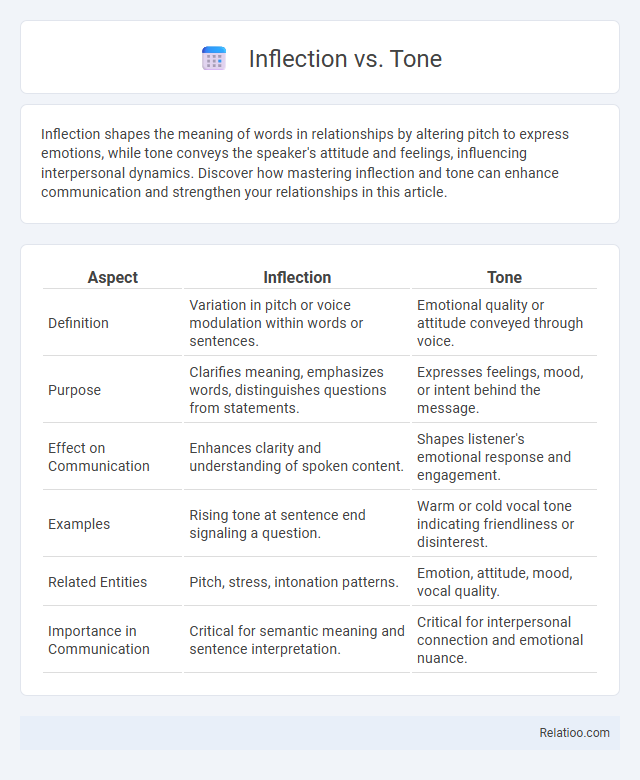Inflection shapes the meaning of words in relationships by altering pitch to express emotions, while tone conveys the speaker's attitude and feelings, influencing interpersonal dynamics. Discover how mastering inflection and tone can enhance communication and strengthen your relationships in this article.
Table of Comparison
| Aspect | Inflection | Tone |
|---|---|---|
| Definition | Variation in pitch or voice modulation within words or sentences. | Emotional quality or attitude conveyed through voice. |
| Purpose | Clarifies meaning, emphasizes words, distinguishes questions from statements. | Expresses feelings, mood, or intent behind the message. |
| Effect on Communication | Enhances clarity and understanding of spoken content. | Shapes listener's emotional response and engagement. |
| Examples | Rising tone at sentence end signaling a question. | Warm or cold vocal tone indicating friendliness or disinterest. |
| Related Entities | Pitch, stress, intonation patterns. | Emotion, attitude, mood, vocal quality. |
| Importance in Communication | Critical for semantic meaning and sentence interpretation. | Critical for interpersonal connection and emotional nuance. |
Understanding Inflection and Tone: Core Definitions
Inflection refers to the modulation of pitch or intonation in your speech that conveys meaning, such as indicating questions or statements, while tone represents the emotional quality or attitude expressed by your voice. Understanding the distinction helps in interpreting spoken language accurately, as inflection alters grammatical meaning and tone conveys speaker intent or mood. Mastering both elements enhances communication by ensuring your message is clear and appropriately nuanced.
Key Differences Between Inflection and Tone
Inflection modifies the form of a word to express grammatical features such as tense, mood, or number, while tone involves the pitch patterns that distinguish meaning in tonal languages. Inflection affects syntax and morphology, changing word endings or internal structures, whereas tone operates at the phonological level, altering the pitch contour without changing the word's form. Key differences include inflection's role in grammar versus tone's function in lexical or semantic differentiation across languages like English and Mandarin.
How Inflection Shapes Meaning in Language
Inflection shapes meaning in language by altering the form of words to express grammatical categories such as tense, mood, voice, number, gender, and case, which directly impact sentence interpretation. Unlike tone, which modifies meaning through pitch variations in spoken language, inflection provides consistent morphological markers crucial for syntactic structure and clarity across diverse linguistic contexts. Mastery of inflection enables precise communication, distinguishing between subtle nuances like past versus present action or singular versus plural subjects.
The Role of Tone in Communication
Tone plays a crucial role in communication by conveying emotions, intentions, and nuances beyond the literal meaning of words. Unlike inflection, which involves changes in pitch, stress, or intonation within a sentence to indicate grammatical or semantic distinctions, tone reflects the speaker's attitude and emotional state. Effective use of tone enhances interpersonal understanding and prevents misinterpretations in both verbal and non-verbal communication contexts.
Inflection Across Different Languages
Inflection in linguistics refers to the modification of a word to express different grammatical categories such as tense, mood, voice, aspect, person, number, gender, and case, and varies significantly across languages. Languages like Latin and Russian utilize extensive inflectional systems to convey syntactic relationships within sentences, unlike tonal languages such as Mandarin Chinese, where tone changes the meaning of words rather than their grammatical function. Understanding inflection's role across different languages can enhance your grasp of language structure and improve communication skills in multilingual contexts.
Tone Languages vs Non-Tone Languages
Tone languages use pitch variations to distinguish word meaning, making tonal inflection essential for semantic differentiation, whereas non-tone languages rely primarily on inflectional morphology, such as prefixes or suffixes, to convey grammatical relationships. In tone languages like Mandarin Chinese or Yoruba, altering the tone changes the lexical meaning of a syllable, while in non-tone languages like English or Russian, meaning shifts through inflectional endings or word order without relying on pitch. Understanding the contrast between tone and inflection highlights the fundamental role of pitch in tone languages versus morphological changes in non-tone languages for encoding meaning.
Examples of Inflectional Change
Inflectional changes modify words to express different grammatical categories like tense, number, or case, as seen in "run" becoming "runs" to indicate third-person singular. Tone, contrastingly, alters meaning through pitch variations without changing the word's form, exemplified in tonal languages like Mandarin where "ma" can mean mother or horse. You can distinguish inflection from tone by examining whether the word's form changes structurally or if the meaning depends solely on pitch.
Tonal Variation and Its Impact on Understanding
Tonal variation plays a crucial role in conveying meaning in tonal languages, where pitch changes can alter the semantics of words entirely, unlike inflection which modifies word forms to express grammatical relationships. Misinterpreting tone can lead to misunderstandings, as the same syllable pronounced with different tones often represents different words or concepts. This dynamic highlights the importance of tonal awareness for accurate comprehension and effective communication in languages such as Mandarin, Thai, and Yoruba.
Common Misconceptions About Inflection and Tone
Common misconceptions about inflection and tone often confuse their distinct linguistic roles; inflection refers to the modification of a word to express different grammatical categories such as tense, mood, or number, while tone involves the pitch used to distinguish word meaning in tonal languages like Mandarin or Yoruba. Many learners incorrectly assume inflection always alters word meaning, but it primarily changes grammatical context without affecting semantic identity. Understanding these differences enhances precision in language learning and avoids conflating phonetic pitch variations with morphological changes.
Inflection and Tone: Their Significance in Effective Communication
Inflection and tone are essential elements of effective communication that influence meaning and emotional context. Inflection refers to the variation in pitch during speech that helps convey questions, emphasis, or contrast, while tone embodies the speaker's attitude or feelings, shaping the listener's interpretation. Mastery of inflection and tone enhances clarity, emotional nuance, and listener engagement in both verbal and interpersonal communication.

Infographic: Inflection vs Tone
 relatioo.com
relatioo.com